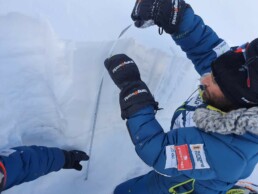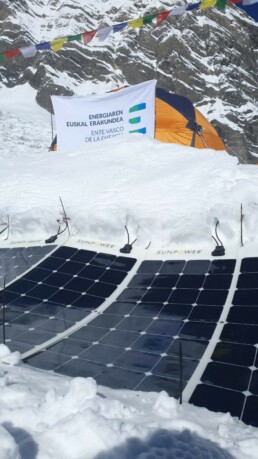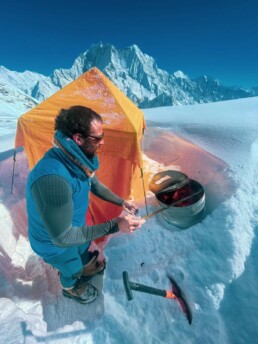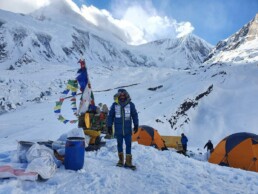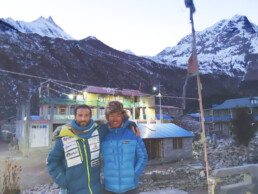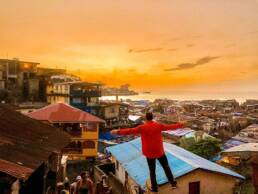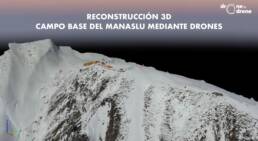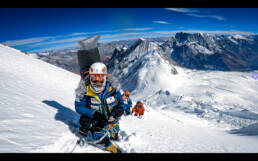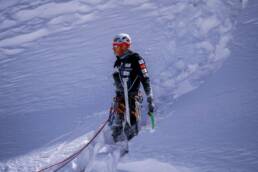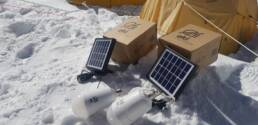Chronicles from Manaslu: Chapter IV
One of the greatest dangers we face on winter expeditions is the risk of avalanches. It is a difficult phenomenon to predict and extremely dangerous. In a few seconds tons of snow begin to fall down and, if you are in the wrong place and time, it can be fatal. This year in Manaslu it is snowing a lot and the avalanches are continuous. We hear enormous roars and sometimes we feel the shock waves that they generate. The truth is, they produce a lot of respect.
To minimize risks, it is necessary to be prepared and take all possible precautions. Our friends from Elur (http://www.elur-equipment.com/) and Sergio Pérez Fernández are doing a very important job in this regard and we keep continuously in touch with them. They help us a lot. Safety is basic in any expedition and we have to try to read the mountain well. Try to predict when a route is safe and when it is not. I leave you with this text prepared by the friends from Elur team, which I believe explains very well the dangers of the mountains:
“As we already know, mountain activities involve a significant level of risk. This is even more present if we talk about mountains in winter, since we add new elements that can endanger our safety. One of the most lethal elements, and even more so when we talk about mountains as big as the ones we face in our expeditions, are avalanches.
During the current expedition of our colleague Álex Txikon to Manaslu in 2021-2022 the team is facing the hardest face of this mountain, since they have suffered snowfalls of more than 2 meters in Base Camp. These abundant precipitations, together with the fact that there is no stable base of snow in the deepest layers, mean that they are living with a 5/5 level of avalanche risk, the highest on the European scale.
As Álex has well said in many of his talks, 92% of mountain accidents are human-caused, that is, possibly avoidable. When we move in terrain with such a high risk of avalanches, it is important to follow a method based on having the correct equipment, training and recycling, having weather forecasts, analyzing the situation and making correct decision-making. As Álex says, the mountain will always be there and in a winter 8,000 mountain, there is no margin for error.
At Elur Equipment we are focused on the development of our avalanche rescue device, but we also work on the rest of this process, since if the analysis steps are done methodically and we bet on the safest option, we can avoid many high-risk situations and save lives
In addition, we do not want to miss the opportunity to thank Sergio Pérez Fernández for his invaluable help in analyzing the current situation at Manaslu.
As we always say, explore your limits, do it safe. "
Chronicles from Manaslu: Chapter III
An almost sustainable expedition is possible. We are doing it and, the truth is, it makes me tremendously proud. Seeing how all the electrical devices in the kitchen or the rest of the domes work thanks to solar energy comforts you. Our footprint will be minimal. In addition, there are times when we even have energy left over and we can share it with other tents. It's amazing.
Just ten years ago this would have been impossible. I believe that it can mark the way forward for future expeditions like ours. Being sustainable is possible and we have an obligation to follow that path. We owe it to these mountains that have given us so much. It is a step that all of us must take.
Working without generators or battery-operated light bulbs is also very comfortable. Ask Eneko, who no longer has to care the diesel to avoid running out of power while preparing the daily meal. Or talk to Sendoa, which recharges all his cameras and computers with power generated by the sun. I would say that we are one of the first expeditions that have energy 24 hours a day in base camp thanks to the sunlight.
All the electrical devices that we use are charged thanks to the plates that Fundación Eki has given us and the essential help of the Basque Energy Agency, which has contributed a lot to make all of this possible. Thanks for your help. Without a doubt, what we are achieving here is a milestone and we are doing it thanks to you. Eskerrik asko!
Chronicles from Manaslu: Chapter II
It has snowed as only here is usually seen. In just 36 hours we have found more than two meters of snow at base camp. It started snowing and hasn't stopped in three days. A pity, because we return to the starting box. It is time to reorganize the base camp, reopen the track and place bamboos, but we were aware that this could happen. There is no other choice but to smile, roll up your sleeves and keep working hard.
We were progressing at a very good pace. In fact, in just five days we had practically managed to ascend to C2. Iñaki and I were carrying up material when the snow began to fall. I decided to go back to BC that same night but Iñaki rested and came down next morning. It was a jug of cold water but the weather forecast, which marked snow, came true and we had to shovel snow for many hours.
Luckily BC was prepared for a situation of these characteristics. I always say that organizing it well is one of the keys to the success of an expedition, because you never know what can happen. We must be ready for strong winds or heavy snowfalls like the one that has fallen on us.
Of course, the tents resisted phenomenally. It is also true that you cannot sit idly by waiting for the storm to finish. You have to take the shovel and start removing kilos of snow. This is how we have been for almost 3 full days. We took a good beating
But it seems that the sun finally shines. After the storm we have some calm. It is time to put everything back together, reset what is our house and, when we do, look up. A lot of snow has fallen and we don't know the way the route will be. What we are sure of is that it will be much worse than a week ago and this will complicate everything a lot. But climbing Manaslu in winter is tough, very tough, and we have to prepare for it. We are really looking forward to it. This has just started and I hope to be back with good news in a few days.
Chronicles from Manaslu: Chapter I
We are working very hard at base camp. It's cold, very cold, and the first days in altitude are always difficult. But the Manaslu looks at us from above and that comforts us. It is as if every morning it says good morning and every night it helps us to rest. It is the first and last thing we see every day. We look at its face and feel that the mountain does the same. We say hello each other. We respect each other. We have a great challenge ahead. We cant’t wait for it.
It has been a busy and intense first few days. It all started with a thousand-hour drive, continued with a lot of paperwork, and finally we arrived in Kathmandu. We spent 4 nights there, in which we took the opportunity to do logistics work (we organized more than 130 packs), legal work (we got the necessary permit for ascent) and do one of the most beautiful and rewarding things there is: helping local people. We did it thanks to various associations and NGOs that do a commendable job and that we know well from years ago. I love to contribute with my grain of sand, although I know that it cannot be compared with what they do. They do an impressive job. I write these lines and I can't help but get excited
We donate computers to 'SOS Himalaya Foundation: Iñaki Ochoa de Olza Foundation', which works with the objective of finalizing the unfinished cooperation projects of the Navarrese mountaineer. We deliver several new laptops that will surely be usefull. And, as on previous occasions, we help also Udana Nepal Foundation, which was created with the purpose of preventing situations of injustice and inequality suffered especially by girls, women and the most vulnerable groups in impoverished areas such as Nepal.
We had a very beautiful and really exciting day with them. Udana Nepal team help a lot to a sector that is practically invisible in Nepalese society. We, for our part, take the opportunity to climb for a while with them in a climbing wall. I think they had a great time and did something different. Their smiles made our day so happy.
Finally, we got to know first-hand the work carried out by Hugging Nepal Foundation. We were lucky enough to see the work they do and, to be honest, it shocked us a lot. They feed people without resources, who thanks to the foundation are able to eat at least one quality meal a day. During the pandemic, they have had very long queues of people who had nothing to put in their mouths. This queue is called 'the queue of shame'. In a country like Nepal the different social classes do not come together and, if they see you in that queue, it is because you are not doing well at all. Seeing all this has been a very hard but it’s the reality.
And after 4 days of paperwork, organizing cargos and learning about the work of these associations, we headed to Samagaun, last village before reaching Manaslu base camp, which is located at an altitude of more than 3,000 meters. This year we have decided to go up by helicopter and we have done it for several compelling reasons. The first because the health and safety measures advised it to do so. The less interaction we have with the people here, the better for them and for us. We cannot risk infecting them. Although we carried out several PCR tests throughout our stay in Kathmandu, it was advisable to have as little interaction as possible with the villages along the way.
On the other hand, we took advantage of the helicopter trip to help several elderly people and children to go down from Samagaun to Kathmandu (in total there were more than 30). Winter in Samagaun is very hard and being able to bring these people down to the capital has been very important. There they are more sheltered. If it hadn't been for these helicopter trips, they would have taken a long time to walk down and many of them would have been forced to spend the winter in harsh conditions in this remote village.
Our stay in Samagaun also helped to gradually acclimatise us. We made short trekkings in the mountains and bivouacked one night at an altitude of 4,300 meters. It has been a beautiful night for us. Eneko and I were very comfortable.
At the moment we are working in our base camp, leaving everything ready. Our experience has taught us that setting up a good camp is one of the keys to success. As I said at the beginning, it is very cold. Last year we reached this same point in mid-January and we don't remember these temperatures. But this is what we have come to. We will continue working hard. The Manaslu awaits us.
Chhepal Sherpa: “At my age, I’m 38, and after climbing a lot, I feel really good, with enough experience for this new challenge”
The world of mountaineering would not be possible without the Sherpas. That's something I've always said. They are a key element of this sport that I respect and love so much. They know the mountain; they will be there to save your life and give you the best advice. That is why I would like you to hear what one of them has to say. This is Chhepal Sherpa. A great colleague on the mountain and a great friend. Here are his thoughts.
Chhepal, how come you are here this winter?
First of all, I´m a climber and fortunately these last 5 years I´ve been on winter ascents: Everest twice, K2, Amadablan and Manaslu last year. This year, I’m here with my team: Tenjin Sherpa, Pasang Norbu Sherpa, Gyalu Sherpa, Thinduk Sherpa and, if we need some help, we also have Pemaba Tashi, our cook, who can also cooperate with us on the mountain.
How many teams will be on the Manaslu?
We are professional climbers. This year we are going to try Manaslu in winter.
Last year, Pasang Norbu refused to go with you (Alex) because he really wanted to climb K2 in winter. Fortunately for us, we have got private financial support for seven summits, which also helps us.
As you have seen lately in the media, Gelje Sherpa is organising a winter attempt on Cho Oyu with Nepali climbers, who are very strong. Last winter, Pasang Norbu went nonstop from the base camp to C4, and also nonstop to the summit of Dhaulagiri. There is also a team of Nepali climbers who want to reach the real summit of Manaslu and we are really motivated about that.
So Chhepal, how many teams are there on the mountain?
More than one. My team will work together with your team, Alex (Txikon, Iñaki Alvarez and Simone Moro), plus sherpa Pasang Rinji. Then, there is an international team with Paula Birgitta, and Mingma Sherpa. Then, Sofie Lenaerts and her husband Steven Maginelle plus Dawa Sherpa team and, finally, Oswaldo Pereira´s team.
But how are we going to organise it all? On the one hand, we are a climbing expedition, on the one hand, there is a commercial expedition?
Alex, we are winter climbers thanks to you. My first winter experiences were with you. We started in winter because of you. Gelje Sherpa or Gesman Tamang or others took their first steps in winter with you. You always make a team. I have learned to create a strong team in the mountain. For sure we will cooperate with your team. Oswaldo is also a very good man, and he is always ready to help. The rest are in the same base camp.
Your second question, the commercial expedition: Sofie’s or Paula’s sherpas are there to assist them all the time. It will be a commercial venture but if they work all the time like us or the rest of the team, it will not be commercial.
About commercial expeditions; in my experience, many people come to Nepal with many sponsors usually in the spring and autumn and wait at the base camp until we Nepalese do the work of placing the ropes above 8,000 metres. In the meantime, they do nothing but post pictures and information on their social media profiles, hiding the reality.
But Alex, I am very confident and convinced that everyone will cooperate.
¿What did you learn from last year on Manaslu?
Last year we were a strong team. This year, I think we will be stronger because more climbers are coming, but let’s see what will happen. Last year I saw you, like always, work very hard. Iñaki also worked very well in the second part of the expedition. Simone has a fast style going up and down, and he works well too at lower altitudes.
Sorry, what route would you like to take?
I prefer the normal route, because we will have less work than last year.
Last year, I also learned to focus on the right moments, on saving energy and being patient as I always am.
I would like to add that the base camp will soon be established by the porters and our cooking staff, but with your (Alex Txikon) and Nati’s brains. You managed to get everything to Samagaon. You managed to move up local porters because you gave everyone headlamps. I´m so happy to be with you again.
How do you feel Chhepal?
Now, at my age, I’m 38, and after climbing a lot, I feel really good, with enough experience for this new challenge.
Thank you very much, Chhepal.
Thanks to you too, and I’m excited to work on the mountain with your team. Let’s enjoy the next few weeks.
From Nepal to Sierra Leona with Eki Foundation
As soon as I landed back from Nepal, with all the setbacks arising from Everest evacuation due to the spread of COVID, my head needed a radical change. A change that will transform a personal project into a joint project. A project that my colleagues from EKI foundation were going to carry out and which I wanted to join instantly. Nothing more and nothing less than to fly to Sierra Leone to collaborate in the installation of photovoltaic stations and thus bring light to remote areas.
But the trip became, as it almost always happens, into a cluster of events, sensations, emotions and experiences that remain marked for life in your retina. An unknown Africa where the landscapes are intense green and the sunsets turn golden after big downpours.The unbearable mosquitoes that I don't get used to, boys and girls with perpetual smiles, friendly and hospitable people who offer what they have for nothing. It has been a real adventure.
We met Father Victor, who has lived in Sierra Leone for 48 years and who experienced the civil war seeing atrocities that would make anyone return to his country immediately, and who, far from taking that step, has spent half his life giving food to starving children, risking his life on more than one occasion by sending child soldiers back to their hometowns.
I have been lucky enough to travel a lot in my life and I have met incredible people, but the days spent in Sierra Leone with EKI Foundation left me speechless. If there is something that impressed me about this trip, it was the slums of Freetown, we saw girls as young as 9 years practicing prostitution, fights that ended in tragedy and in the middle of that panorama, an Argentine Salesian father who cares for about 2,000 children a year.
Undoubtedly a country that has not left me indifferent and full of contrasts. Beautiful landscapes and people with an infinite smile in front of a very harsh social reality where violence is very present. The crude reality
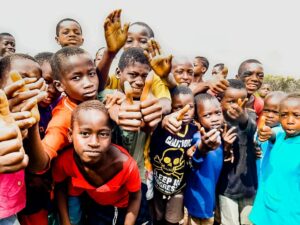
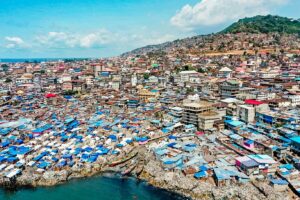
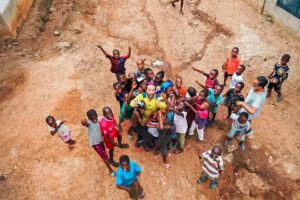
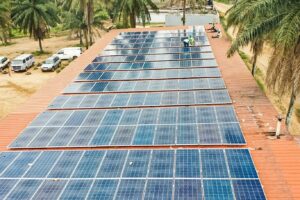
ManasluEki BC Reconstruction in 3D using drones
As you know, in our expeditions, in addition to working hard in high altitude rotations, we also collaborate in development of environmental, technological, social projects ... In this case I want to tell you about the drones 3D reconstruction work done at #ManasluEki BC. A project we carried out with Drone by Drone, the first drone operating company authorized by the State Agency for Aviation Safety in Euskadi, and that, thanks to the use of UAS for monitoring, study interesting situations for the safe development and sustainable expeditions like the ones we carry out. Nothing is like teaming up with people from home and experts in their own business; thanks to them we have been able to share with you on my RRSS channels some very cool aerial images training in Gorbeia area and now a very special project in Manaslu.
The #ManasluEki BC 3D reconstruction project by drones has been possible thanks to the photogrammetric restoration technique using drones, which allows 3D reconstruction for the analysis of the environment.
It sounds convoluted, but I will explain what it consists of and what purposes these 3D reconstructions have in addition to the recreational purpose, because the digital model generated allows the measurement of multiple parameters on it, being able to export the information in multiple formats for its exploitation and analysis to GIS or CAD type programs
In this way, in the mountains, the use of drones not only provides spectacular images, but they can also provide us with data for subsequent analysis in important aspects as safety, sustainability, environment or local atmospheric phenomena.
- Analysis of the erosion generated by the human presence in base camps
- Presence of garbage and even possibility of volumetric measurement of it to determine mitigation and elimination measures
- Observation and measurements of seracs movements dangerous for climbers
- Glaciers observation and measurements, for the evaluation of their retreat or loss of mass due to climate change and human impact on them.
- 3d audiovisual content realization, for interaction , base camp virtual tours or interesting ascent areas tours. In this way, a more real immersion in climber’s daily life and in the expedition is achieved, and also to get the audience closer in a more realistic way, without having to submit to the risks of expeditions to Himalayas.
ManasluEki BC Reconstruction in 3D using drones
An unforgettable experience
We quite had it. It was close. We could almost touch it with our fingertips. But no, we have not been able to ascend to Manaslu. Some could consider that we have failed. Nothing could be further from the truth. We are very satisfied with the work done. And I'm not saying it to look cool. It's something that I really feel. I leave with a big smile and with the calm of having done everything in our power, with cool mind to make the decisions that made us return alive.
This is not like a football game, in which some win and others lose. The only time you lose in the mountains is when you don't come back from above. And this year, unfortunately, we had too much of this. I am so sorry that friends and colleagues didn't return home… It is the worst side of this wonderful sport that keep us so hooked. Too expensive the toll they had to pay. May they rest in peace. The world is a sadder place without them…
We have accomplished so many things throughout these unforgettable weeks. In sports and personally. We managed to ascend to 7,100 meters in the middle of winter and on a never explored route. It was beautiful, but also tough. Very hard. On some occasions I admit we have pushed a little harder than we should have, but I know that if we were in the same situation again we would do the exact same thing. We carried up many kilos of material and we opened track with more than a meter of snow, covered by the white blanket almost to the waist. We knew what we were up against and, in a way, we came to that. And if it hadn't been for that rimaye we found between first and second camps or if the window of good weather had lasted a day and a half more… Well, as they say, “it is what it is”. There will be time to analyze what we have done with more calm.
It has also been a great experience on a personal level. A fantastic group has accompanied me. I know that while I am focused on an expedition I can be more difficult to carry on. I keep focused and the machine in me comes out.
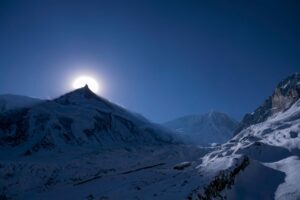
It has been a joy to go back to the mountains and first level mountaineering with a friend like Iñaki Álvarez. He really is a machine. A calm person, who never loses his temper, and who is always willing to give you a hand. The type of partner that we all want by our side when things go wrong. I have also learned a lot from Simone Moro, a top-level climber, and climbing comrade in several occasions. I will never forget how he mobilized everything he could on the day of Sergi Mingote's fatal accident. He told me about everything and I know he could not do anything more. Eskerrik asko to both of you for having accompanied me on this wonderful adventure. Surely we have many more to share.
I would like to say a few words to the wonderful group I had by my side at base camp. I am not going to list them one by one, because I would need almost one chapter for each and every one of them. Eskerrik asko to all of you. Your work at base camp made it possible for us to reach 7,100 meters.
And, of course, eskerrik asko, from the bottom of my heart, to all the sponsors who have made this 39-year-old kid enjoy this opportunity. I have done it in the best way I know, but in the mountains, no matter how much you prepare, you are at the mercy of the circumstances of each moment. It has been a wonderful journey. An unforgettable experience. Eskerrik asko!
The luxury of being able to share this adventure with Iñaki
Most of you will not know Iñaki but we have had the luxury of being able to share this project with him. Iñaki Álvarez, a Gipuzkoan from Zumarraga with a passion for history and archeology, is a calm, silent man. His humility is on par with the enormous illusion that he has put into this adventure from the first minute when Alex told him if he wanted to come to Manaslu with us. Iñaki had already been on expedition with Alex 20 years ago together with Jon Maroto and Xabier Ormazabal. Of the 4 who made up that expedition, only Iñaki and Alex are still alive.
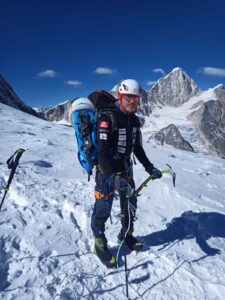
Just a few months ago he told us about the relationship he has had with the mountain throughout his life. Here we post a brief text he wrote us just a few weeks before leaving.
“The mountain is a passion that I have inside since my youth. This has led me to climb far mountain ranges throughout my life. I perfectly remember my first experience with "altitude sickness", it was on Mont Blanc on the Grands Mulets route in 1999, if the first day we went down dizzy the second we insisted on climbing to the top. That same year I saw a mountaineer die for the first time, he was climbing Hornli ridge to the Matterhorn. Later I also climbed the Lyon ridge to this same peak and many other routes such as the Mitellegui to the Eiger, the east spur to the Ober Torberg, Dent du Geant, Weisshorn etc.
In 2001 it was my first experience above 6000 meters, and the first time I saw frostbite, on my friend Jon Maroto's fingers, after coming down from Huascarán. I travelled to Peruvian Andes (Cordillera Blanca) and Bolivians (Cordillera Real) in different years to climb other peaks such as Toclaraju, Huaina Potosi or Illimani.
I visited the African continent in 2008 with my friend Koke Lasa to go to the Atlas Mountains, where we climbed several peaks, including Toubcal on the corridor route. But the top of that activity was the ascent to Biiguinoussene (4002 m) by a new route, which we did not see cataloged, and about which we did not give news. I'd say it was a D + grade.
My trip to Pamir in 2002 was quite an experience and a high mountain lesson that I will not forget. There I met Alex Txikon, and although we did not summit, our friendship lasts, so that is what I took back home from that great mountain.
Perhaps the top of my humble alpine career would be the expedition to Shisha Pangma in 2004, since we left aside the normal route to climb the central corridor of its north face, of a thousand meters with about 55º maintained, which led directly to the top . It was opened in 1987 and we entered that year after being first promoted by our friends Unai Pérez de Arenaza and Oriol Baró, who encouraged us to climb that huge ice slide".
Thanks Iñaki for being up there taking care of Alex and the rest of the team.
EKI-SOS Himalaya: a high-altitude collaboration
The expedition we are carrying out this year has a marked humanitarian and solidarity value. I always try to make it that way, but this year it had to be more than ever. The pandemic generated by COVID-19 has hit all of Nepal very hard. Not so much at contagion level, but at economic level. The people here live largely from tourism and this year, as we all know, we have hardly been able to move from our countries. When I spoke with them on the phone before coming, they all passed the same idea to me: “We are suffering a lot. Everything is stopped and this is unsustainable. People are having a very bad time ”. Worry invaded his words.
I knew, therefore, what we were going to find. This is why, together with EKI Foundation, we got down to work. We had to think about how we could help them. Always within our means, of course. We are a committed but very small team with limited resources. But we had to find the formula. There are no excuses here. Nepal has given me so much and I always feel that I am indebted to them… In a way, I owe it to them.
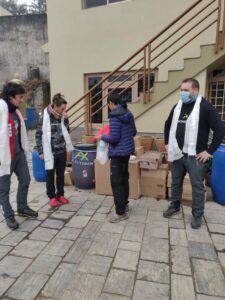
Well, after looking for formulas with EKI Foundation, we thought we could help them in two different ways: by giving them 60 autonomous light bulbs and by giving them the solar panels we have brought to Manaslu base camp that provide us with all the energy we need in our daily life.
But we needed to put a third protagonist into the equation. Someone to tell us where and to whom to deliver material. Someone who knew first hand and better than anyone Nepalese people’s needs. And here it’s where Iñaki Ochoa de Olza-SOS Himalaya Foundation came in. We got in touch with them and everything was very simple. Our job would be to receive EKI Foundation material and take it to Nepal. So we did it.
During our first week in Kathmandu we met with them and delivered the first batch of products: 60 autonomous LED bulbs, which can work thanks to a solar panel attached to them or which, if desired, can also be turned on with normal electricity (although cuts, as is common in some areas). That is to say, these bulbs have a lithium battery that is charged thanks to the sunlight or the electricity that can arrive. If it gets dark or the power supply goes out, the battery is charged and the bulb continues to work for up to 8 hours. A simple system, but extremely effective. In addition, these bulbs have a USB input and a microjack and the system can be activated with a remote control. A light bulb in a home can mean that girls and boys can study, that their day does not finish with the night.
Once we finish our expedition in Manaslu, we will deliver the second batch of material: solar panels that supply us with energy in base camp and prevent us from having to use generators and consume fuel (without forgetting the environmental impact we are avoiding). But first we have the challenge of climbing a giant of 8,163 meters, and it is not being so easy for us. Eskerrik asko to Iñaki Ochoa de Olza SOS Himalaya Foundation for helping us bring all this material to the areas where it is most needed and to Fundación EKI for making it possible. We are getting renewable energy to reach the most remote places on the planet and helping many families to improve their lives.

